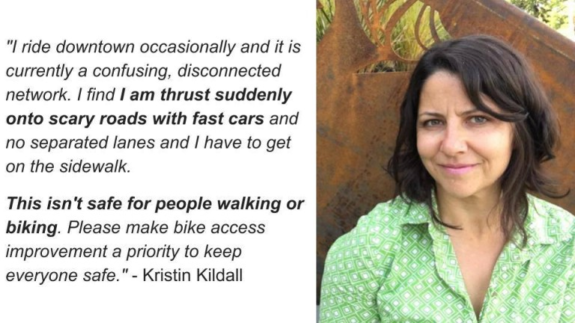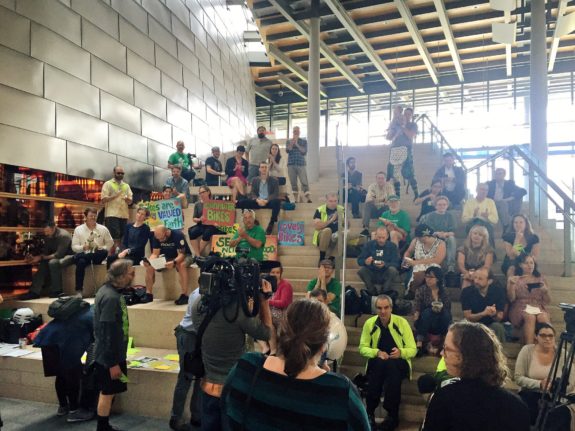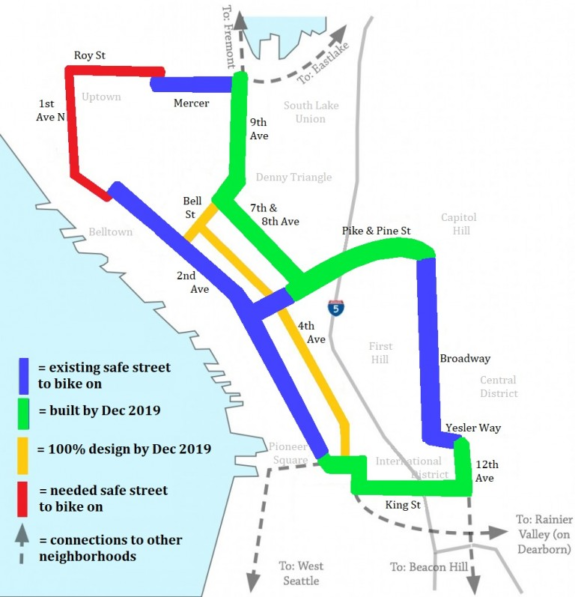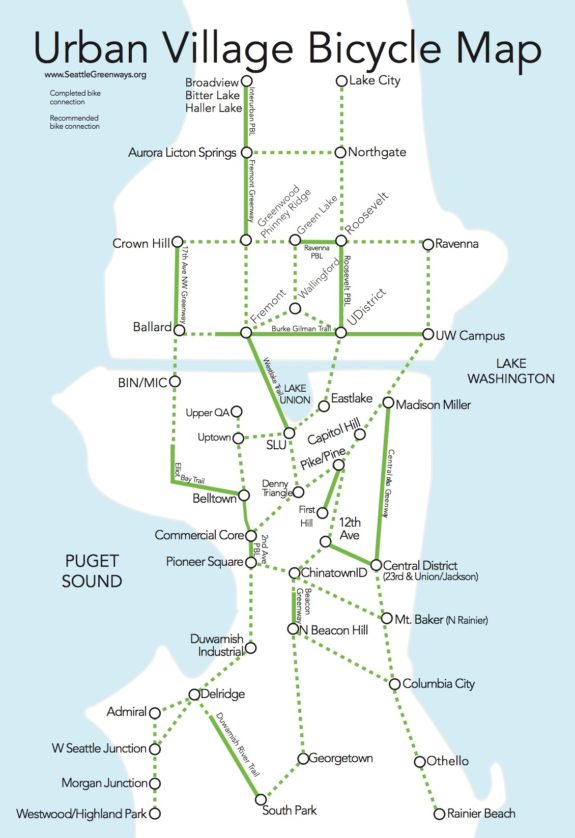Editor’s Note: Seattle Bike Blog reported yesterday on newly-released 2017 American Communities Survey data that estimates that the number of people biking to work is declining in Seattle. In response, the folks at Seattle Neighborhood Greenways wrote this guest post looking at the start-and-stop construction of a useful bike network in our city and discusses where we can go from here.
The number of people biking to work in Seattle has not been growing. This is disappointing, but it is neither surprising nor is it an inevitable trend.
60% of people in Seattle want to bike more but don’t. They want to bike more because biking for transportation makes us happier, keeps us healthier, saves us money, and reduces pollution.
But safety is the number one reason they choose not to.
The reality is that Seattle’s bicycle routes are still fragmented, inconsistent, and dangerous. We need quick implementation of a large-scale, connected network of safe, protected routes in order to see meaningful change in how people are choosing to get around.
 After Sher Kung was tragically killed by a driver on 2nd Ave in 2014 the city acted quickly to build the first protected bike lane in downtown Seattle, but progress since then has been lethargic. In 2016, former Mayor Ed Murray put the Basic Bike Network on indefinite hold.
After Sher Kung was tragically killed by a driver on 2nd Ave in 2014 the city acted quickly to build the first protected bike lane in downtown Seattle, but progress since then has been lethargic. In 2016, former Mayor Ed Murray put the Basic Bike Network on indefinite hold.
Seattle Neighborhood Greenways pushed back against this delay. Led by family bikers, we filled City Hall holding signs saying “My Family Bikes” and “Safe Streets Now,” and chanting “We can’t wait!” As a result of these protests, planning for the Basic Bike Network moved forward.

When Mayor Jenny Durkan’s administration took over, they delayed the Basic Bike Network again. And again, a groundswell of caring people joined us to push back against the delay by emailing, calling, and taking to the street:
In response, City Council rose to the moment and passed a resolution to finally extend the disconnected 2nd Ave protected bike lane to the Westlake trail, Capitol Hill, and International District by the end of 2019.
 More work remains to be done. We need to complete the Basic Bike Network for Uptown and the new arena, and connect it to the rest of the city. Seattle Neighborhood Greenways has been leading the charge by pushing for solutions that work for Uptown, listening to the Chinatown-International District community, and doing extensive outreach on Pike/Pine.
More work remains to be done. We need to complete the Basic Bike Network for Uptown and the new arena, and connect it to the rest of the city. Seattle Neighborhood Greenways has been leading the charge by pushing for solutions that work for Uptown, listening to the Chinatown-International District community, and doing extensive outreach on Pike/Pine.
But even as we work to make it easy to commute by bike, we need to remember that getting to work only represents 25% of our daily transportation needs. We also need to make it convenient and comfortable to bike to the store, to see friends, to school, and more. That’s why in 2016 we worked with our neighborhood chapters to envision a system that connects every growing neighborhood (the map is not to scale).
 Piece by piece, our grassroots neighborhood-based chapters are bringing this vision to reality because people like you are rolling up their sleeves all over the city:
Piece by piece, our grassroots neighborhood-based chapters are bringing this vision to reality because people like you are rolling up their sleeves all over the city:
- West Seattle Bike Connections is working to connect the spine of West Seattle and Delridge to downtown.
- Duwamish Valley Safe Streets is working to connect Georgetown and South Park with a trail.
- Beacon Hill Safe Streets is working to connect to Columbia City and the International District.
- Rainier Valley Greenways is working to connect the Rainier Valley to the rest of Seattle.
- Central Seattle Greenways is working to connect Capitol Hill to Downtown and the Central District.
- Queen Anne Greenways is working to connect to the new Seattle Center Arena.
- Green Lake & Wallingford Safe Streets is working to connect to and around the park.
- Lake City Greenways and University Greenways are working to connect people to new light rail stations.
There are no shortcuts to make biking in Seattle welcoming, comfortable, and convenient for people of every age, language, ethnicity, gender, race, ability, and level of wealth. Changing our streets and transportation system to reflect our values and needs requires on-the-ground advocacy and community-building in every neighborhood — work that our staff and volunteers do everyday. But to win, we need everyone who cares to be a part of this movement.
Here are four ways you can join:
- Join us on Friday, October 5 for an inspiring evening of ideas at Building the Cycling City: Dutch Lessons for Seattle, including how to address Seattle’s gender gap.
- Sign up to volunteer with us or attend our next Volunteer Orientation on Wednesday, October 17
- Donate to support our grassroots organizing to make every neighborhood in Seattle a great place to walk, bike, and live. Right now we have a 2-1 match, meaning your $100 contribution will become $300!
- Ride a bike, and bring a friend!








Comments
12 responses to “Seattle Neighborhood Greenways: Disappointing bike commute data is ‘neither surprising nor inevitable’”
Thanks Gordon, Clara, Susan and everyone else at SNG!
I realize that folks are still looking over the Mayor’s budget that was just released, but we also desperately need people pushing on Councilmembers to make the budget less about cars and more about transit, walking, and biking. Just yesterday, Councilmember Juarez proclaimed that “not every neighborhood needs bike lanes”. She is clearly not hearing from constituents who would like safer routes around district 5.
Sigh, the survey question about commuting asks for multi-modal commutes to choose the one with the longest distance (as opposed to longest time or allowing multiple): https://www.census.gov/acs/www/about/why-we-ask-each-question/commuting/
I also dislike questions worded in the form of LAST WEEK because that brings high variance due to business travel, vacation, local weather, seasonality, etc. If the survey is sent out staggered across the year, that helps, but it sounds the sample size would be pretty low (about 1% of the population, so if 4% of Seattle bike commutes, there’s not really much statistical power in what remains, basically a few hundred people, ideally spread over the year).
[…] Seattle Bike Blog looks at a recently-released report on bike commuting in Seattle, with some disappointing results. […]
“After Sher Kung was tragically killed by a driver on 2nd Ave in 2014 the city acted quickly to build the first protected bike lane in downtown Seattle”
That’s a bit of revisionist history. It was much worse then that as the 2nd ave. bike lane was being constructed when Sher Kung was killed.
“When the Aug. 29, 2014, crash occurred, the city was less than two weeks away from improving its left-side bicycle lane on one-way Second Avenue”
The City was found guilty and forced to shell out $3.5 million (that’s would be a nice Greenway). What has changed? Absolutely nothing. They made a ridiculous statement that has never been enforced. –
http://sdotblog.seattle.gov/2016/10/05/new-advanced-notice-for-bike-lane-or-greenway-closures/
“That’s why, starting this week, conditions for construction permit approval include on-site signage 72 hours in advance for work that closes or impacts a bike lane or trail.”
In the last two weeks alone I have come across both Greenways and bike lanes that were closed for permitted construction work with no advanced notice at all. And just like 2nd Ave there was no indication given as to where peds and cyclists were supposed to go other than a sign that says “bike lane closed” or “sidewalk closed.” God forbid they temporarily remove parking or a travel lane for the sake of ped and bike safety.
SDOT is a joke. Maybe they will finally learn their lesson after a few more multi-million dollar payouts. I’m not optimistic.
I didn’t know about that rule, but it certainly was not followed for the bike lane closure through part of the missing link in Ballard on 45th street. Below is an email I sent to Mike O’Brien yesterday for which I’ve not gotten a response. A year or so ago I tried emailing SDOT about the closure of the bike lane on 34th in Fremont but it was completely ignored. No one gives a @#$%^ about bicycle riders or pedestrians, construction is the only think important.
—————–
Hello,
I am writing about the loss of bicycle lanes on NW 45th street between 14th Ave NW and 15th Ave NW due to the construction on the adjacent lot. I am very disappointed that the construction is able to take away the only safer way through that part of the missing link without providing any adequate and comparable detour for bicycles and other trail users. Heading east the detour is on the road itself which along with the train tracks being even more dangerous to cross there is always speeding vehicles. Heading west ? Well, you are out of luck. There isn’t even an attempt at a detour. I use this route every single day on my bicycle, rain or shine and so this is a critical issue for me.
The fact is that construction ALWAYS takes priority over bicycle lanes all over the city. Another example was the bicycle lane on 34th street in Fremont which was closed for at least a year or more to accommodate storage for the construction company. The message to me and others is that bicycle riders are not important but construction and drivers are.
The closure on NW 45 looks as if it will last a long while as there is a fixed crane right on top of the bicycle lane. Luckily there is a good solution here that will benefit the users of the trail and not impact drivers or the construction company at all. The existing car lane on 45th is one way going west. This one block should be closed to vehicle traffic and replace the closed trail adjacent to it so the trail can be bidirectional. Vehicles heading east can just bear right and use Shilshole Ave instead. This is parallel to 45th and not any kind of inconvenience since there are stop signs at 14th Ave anyway. The construction has access from 14th ave and from the now closed bicycle lane.
I am not hopeful that the city will change its attitude towards bicycle and other trail users, construction and vehicles, but in the case of NW 45th it should be simple to make this work for all of us involved. What is the next step to make this happen ?
I was just telling someone that I thought by now after moving to Seattle, car free, we would have better transit and bike infrastructure. It’s also at this point that we have to really get to places that are beyond where I thought we would bike regularly and nothing connects. Of course getting out of South Seattle is a big PAIN IN THE BUTT but their are always these weird segments where I still have to map out and plan. I mean, nobody does that in a car, unless they are weird like us when we have had to drive to some weird place in Kirkland. It’s exhausting to have to beg city leader to make transit/walking/biking better. Greenways basically highlighted all the times we had to rally to BEG! I’m just trying to get to our doctor’s appointments, this is a not a for funsies ride. Why does the mayor and the city council make it so hard? Maybe Durkan can do a whole week of a bike along with me and my 4 year old and see how exhausting it is mentally to get through some of the dangerous segments which also are dangerous for ANYONE outside a car! Yesterday the CD Greenway was closed for a block and that induces panic because I wasn’t planning for that! Neither was my teen or my 4 year old who hates alternate routes because he has the ONE memorized in his brain. https://twitter.com/NoSpandexReq/status/1045449426725040128
It’d be great to support the greenways projects if the ones already built were helping get more people out on bikes. Unfortunately, they’re not, and this data proves it. All greenways have done so far is move traffic from greenways streets to adjacent side streets, with the same asshats causing the same trouble now one street away. This program spends tons of cash without tangible results, and those of us biking to work are still one idiot driver away from dying unnecessarily. Separated bikelanes on major roadways, or we’re just pissing up a rope.
I’m not sure I’m following your logic. A network of Greenways that connects to trails and PBLs is great. I really like the 58th St and 17th Ave NW Greenways in Ballard. They have stop signs on the cross streets and priority push buttons when possible to cross the arterials safely and efficiently. I find those Greenways much more pleasant, lower stress, and less chaotic than the Roosevelt or Dexter, and I would greatly prefer the current greenways on an adjacent street to a PBL on Market or 15th Ave NW. (the interesting note there is the comparsion to 35th Ave NE and the 39th Ave Greenway… 2 blocks vs 4 blocks, and Market/15th Ave NW are pretty ugly high-speed arterials compared to 35th Ave NE.)
There’s enough elevation gain between 39th and 35th in many areas that it’s not a great comparison. There’s no similar side street that ‘goes through’ by 35th Ave. The vast majority of the destinations in that neighborhood are on 35th. The city needs to allow corner stores, but that’s another story. Five block spacing (more or less) for safe biking infrastructure is completely reasonable in a city that would aspire to something more than 2% bike.
Councilmember Juarez asked for sidewalks rather than bike lanes. To me, these arterial bike lanes are functionally acting like low-cost sidewalk widening. The city could have put bioswales on 125th. They could have put wide patio seating on Pinehurst way, and they could have physically widened the sidewalks on 35th Avenue. Any one of those choices would have been valid ways to narrow lanes and calm traffic on streets that have quite a few safety issues.
I assume such changes would have cost nothing, certainly much less than a paint strip or a truck load of plastic posts. Terry street in South Lake Union took this approach and I’ve not heard a peep about the cost. It’s not much use for biking, but the sidewalks are wide, there’s plenty of seating, the plants seem happy enough and the surrounding blocks are completely dominated by cars.
BR,
Seattle Neighborhood Greenways as an organization has been working on much more than just neighborhood greenways for years. Our first effort to bring neighborhood greenways to Seattle gave us our name, but since then we have been championing trails, protected bike lanes, sidewalks, and crosswalks all over the city.
And FWIW, well design neighborhood greenways can lead to increases in biking, as Portland and Vancouver have shown. Some are also fairly successful in Seattle:https://www.seattletimes.com/seattle-news/transportation/what-we-can-learn-from-seattles-bike-counter-data/
https://www.seattlebikeblog.com/2014/07/23/do-neighborhood-greenways-increase-cycling-oh-yes/
One of the biggest issues with our Greenways is they do nothing to reduce car traffic in most places. When I biked in Portland they put barriers to prevent cars from turning from arterials onto Greenways. Similar to the one at 15th and 58th in Ballard. The problem is other major arterials don’t have these barriers which increases the amount of cars that use the Greenway streets.